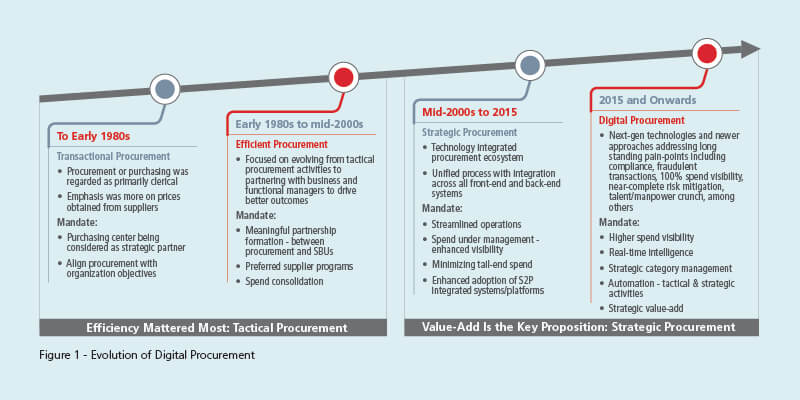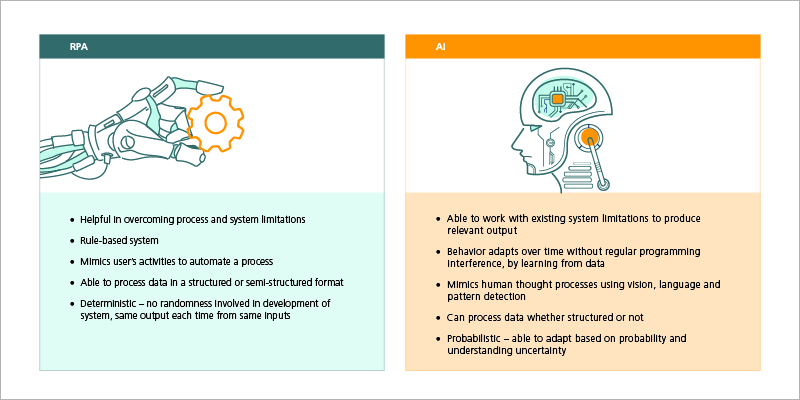
How Disruptive Technologies Will Transform the Future of Procurement
June 01, 2020 | Procurement Software 7 minutes read
The rise of cutting-edge, disruptive technologies is changing the face of procurement. Intelligent automation that uses sophisticated intelligences such as Artificial Intelligence (AI), machine learning (ML), Robotic Process Automation (RPA) and Smart Bots are redefining the future of procurement technology. Along with the process of procurement itself, the role of the procurement professional is subject to transformative change as well.
Fears, uncertainties and concerns have begun circulating around the question of how disruptive technologies will impact the professional landscape for the procurement workforce. Simply put, professionals are worried that their jobs are at great risk as various operations are being augmented or taken over by new technologies in procurement.
We are currently in the Fourth Industrial Revolution, in which advanced technologies like the Internet of Things (IoT), robotics, Virtual Reality (VR) and AI are creating a profound impact on how we live and work. Across the workforce, technology is freeing human capability from repetitive, tedious work, enabling people to focus their time and efforts on activities that drive value and entrepreneurship. The key is not to fear technology, but to embrace this age of technological advancement and innovation. In fact, exploiting human strengths over machine intelligence will be imperative to staying ahead of the curve.
Disruptive Technologies Have Put the Procurement Function in A State of Flux
From nascency, it’s been in procurement’s nature to evolve — to continuously push the function forward, drive innovation, and find new opportunities to mine value and growth. Since the 1980s, there has been a radical and holistic shift in the function. Procurement evolved from a tactical operation of transactions and purchasing to a more strategic process integrated with other business functions to drive profitability and increase savings.
The development of unified, source-to-pay digital platforms revamped the function, streamlining operations, enhancing visibility and facilitating better spend management. As the wave of innovation brings in new and emerging technologies, the function will evolve, yet again. While it’s understandable that people could be skeptical and concerned about these effects on the procurement professional’s career, it is truly an exciting time. The advent of disruptive technologies invites tremendous opportunity to reimagine the operation of procurement for the better, broadening its horizons and changing the possibilities of what can be.

How Will Disruptive Technologies Impact Procurement Processes?
The bulk of a procurement professional’s responsibilities lies in the creation, analysis and management of data and various workflows — tactical procedures that are often time-consuming and tedious. Disruptive technologies would offer tremendous value to several areas of procurement, enhancing operational efficiency, productivity and performance through automation and intelligence. For instance, a combination of RPA and blockchain technology would enable the creation of smart contracts. These digitized contracts utilize various computer protocols to draw data, and measure against contract criteria to monitor and manage the performance of supplier contracts and relationships. The implementation of smart contracts would help drive more savings and value to the bottom line, preventing erroneous or duplicate orders as well as underpayments or overpayments.
Another area of procurement that would benefit from emerging technologies is user experience. Chatbots that utilize Natural Language Processing (NLP) either used to directly interface with customers or used in customer support functions, would facilitate more effective user experiences. Many companies today have begun using smart Chatbots in their customer support functions to interact with customers and online visitors. With their 24/7 availability, smart Chatbots reduce the need for constant human monitoring and enhance companies’ customer satisfaction levels, efficiency and productivity.
“New disruptive technologies would offer tremendous value to several areas of procurement, enhancing operational efficiency, productivity and performance through automation and intelligence.”
Other powerful, disruptive technologies will offer transformative improvement to procurement, facilitating the generation of actionable insights and strategic decision-making. Machine learning utilizes an intelligence that draws upon vast data sets to track patterns, create models and learn over time. This sophisticated intelligence also has the capacity to learn the patterns and behaviors of an enterprise’s business activities to predict and anticipate outlier events.
Cognitive processing is another powerful intelligence that uses analytics and models to create solutions to complex business problems and predict opportunities for value realization, while mitigating risk. The combination of machine learning and cognitive processing proposes profound impact to the function of procurement. This game-changing partnership of intelligences would enable procurement professionals to ask questions like, “How many suppliers do I have in x category?” or “What does spend look like in x region?”— and anticipate answers that offer meaningful, value-adding insights.

How Will New Technologies in Procurement Impact the Procurement Professional’s Career?
Machine intelligence excels in operational processes and with much better efficiency and accuracy than humans. Also, while humans would eventually tire of tedious, repetitive work, robots wouldn’t. Therefore, it doesn’t seem that far-fetched to imagine certain aspects of the procurement function managed entirely by machine intelligence. One might question what the need is for human intervention at all. Could the entire source-to-pay process be automated?
Whether or not an entirely automated process is possible is one thing; however, this will most likely not be the case. The answer to this question comes down to the initiatives and goals that are most important to the function. Sure, if procurement is considered a mere operation of tactical purchases and transactions in which goods are sourced and purchased to maintain cost-efficiency, then the function could be automated. However, in a purely automated system, various machines would end up in standstills with their respective algorithms battling against each other. Does that scenario paint a picture of progress and value realization? Without human capabilities as well, the operation would suffer, and tremendous opportunities for growth, value and savings would be missed.
How Can Procurement Professionals Deliver Value to Their Enterprise Clients Using New Technologies in Procurement?
To continue driving value to the enterprise, an effective use of emerging technology in procurement will serve as the catalyst, helping to elevate the function from a transactional operation to that of a trusted business partner and advisor. Conducting processes in the same way will not drive the function forward. After all, repetitive, tactical processes can be automated by machines. Procurement’s goal must be to find the most profitable and effective ways to spend shareholder capital and to uncover new opportunities to derive and realize value.
To deliver value to clients, procurement professionals need to engage more closely with enterprise customers, gain deep understandings of their challenges and priorities and become more directly involved in the product life cycle. This also includes strategically sourcing new suppliers and leveraging the knowledge of market trends and dynamics to mitigate risk. What matters most to the enterprise client is at the beginning—identifying problems and opportunities — and the end—creating and delivering solutions.
However, procurement professionals must spend a lot of time on repetitive processes and operations necessary to deliver these solutions. These tactical activities that include preparing and analyzing reports, trying to extract meaning from data, etc. leave the most to be desired, being unstimulating and monotonous in nature. This is the area of procurement that is most at risk and serves most to gain from automation, freeing the procurement professional to focus on high-value initiatives.
How Can Procurement Professionals Partner With Machine Intelligence?
Procurement professionals need to distinguish functions in which machines have the upper hand and capitalize on the advantage of new technologies. In procurement, disruptive technologies like machine intelligence should augment the human effort — not replace it.
Creating a partnership between humans and disruptive technologies will include a holistic approach that combines traditionally left-brain and right-brain skills. As social creatures, humans have highly developed soft skills. Social and emotional intelligence gives humans the ability to build relationships, and through interaction, understand, motivate and persuade each other. We also apply critical thinking to solve complex problems. Too list some of our weaknesses, we are often subject to biases that can sway our behaviors and decision-making.
Machines’ strengths include the performance of repetitive tasks, analyzing large data sets and conducting statistical analyses with much more efficiency and accuracy than humans. As for their shortcomings, we can summarize that machines lack in their ability to make strategic decisions or evaluate abstract information.
Skills like logic, data and analytics that machines are proficient in will need to merge with the creative, empathetic and conceptual skills native to humans. In areas such as supplier management, procurement professionals have the advantage of skills like visual comprehension, creativity and communications to develop strategic and sustainable relationships. In strategic category management, machine intelligence can enhance areas like logic, reasoning and analytical thinking to drive value, in combination with human skills like communication, negotiation, persuasion and decision-making.
How Can Procurement Professionals Best Prepare for the Future of Procurement Technology?
Procurement has historically been an operation run by business professionals who are entrepreneurial to the core, exercising innovation and creativity to deliver solutions to their clients. In this digital-first world, procurement professionals must continue to leverage entrepreneurship to cultivate their organizational networks, grow supplier bases, and continuously identify opportunities for value-realization. New technologies in procurement will be instrumental in helping them more efficiently and effectively fulfill these objectives.
Since it is futile to attempt to push back against technology, the key is to use machine intelligence to help realize the strategic vision of procurement initiatives. Adopting disruptive technologies will expand the possibilities of the function itself, helping catapult clients to new heights of financial success and growth, as well as bringing procurement to the forefront of business operations. Procurement professionals would also benefit from changing their mindset, in which they act as “disruptors” themselves, disrupting their current operations to fully embrace and utilize the tremendous capabilities technology has to offer.
Conclusion
Procurement has undergone immense transformation as it has evolved through the decades. And the time is ripe to reinvent the function once again. While it’s natural to approach this new age with some hesitancy, concern and skepticism, there’s no doubt that machine intelligence in partnership with human capability will expand the possibilities for procurement, business operations— and for that matter — our world, as we know it.
To learn more about the profound impact the bot age will have on procurement operations and the professionals within the field themselves, check out the webcast: Humans vs Machines: The Role of Procurement Professionals in the Bot Age in GEP’s Knowledge Bank.



